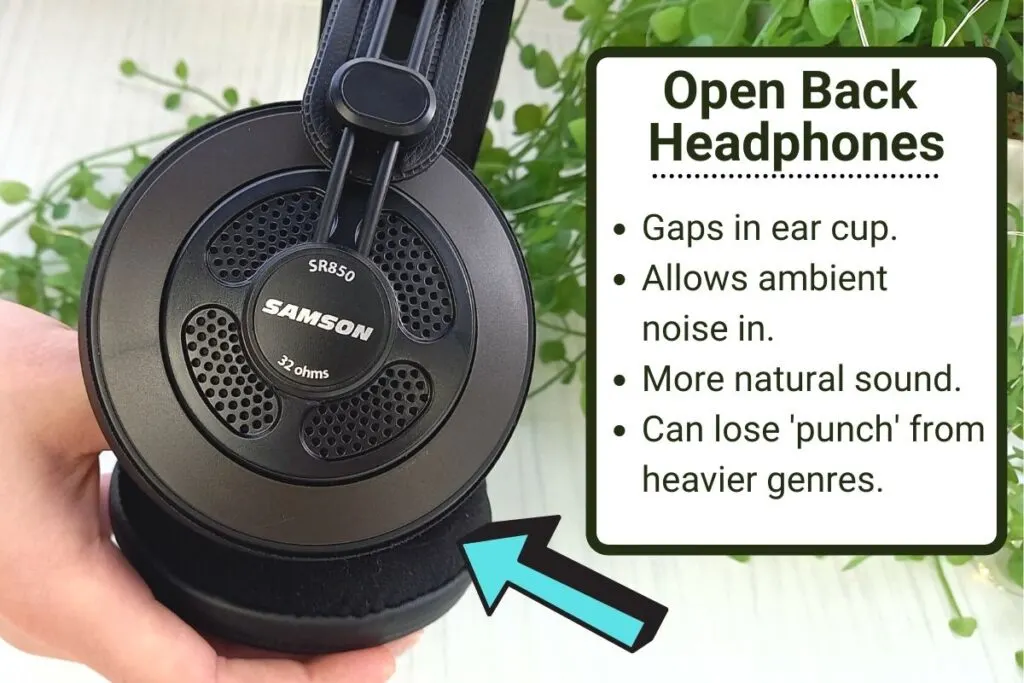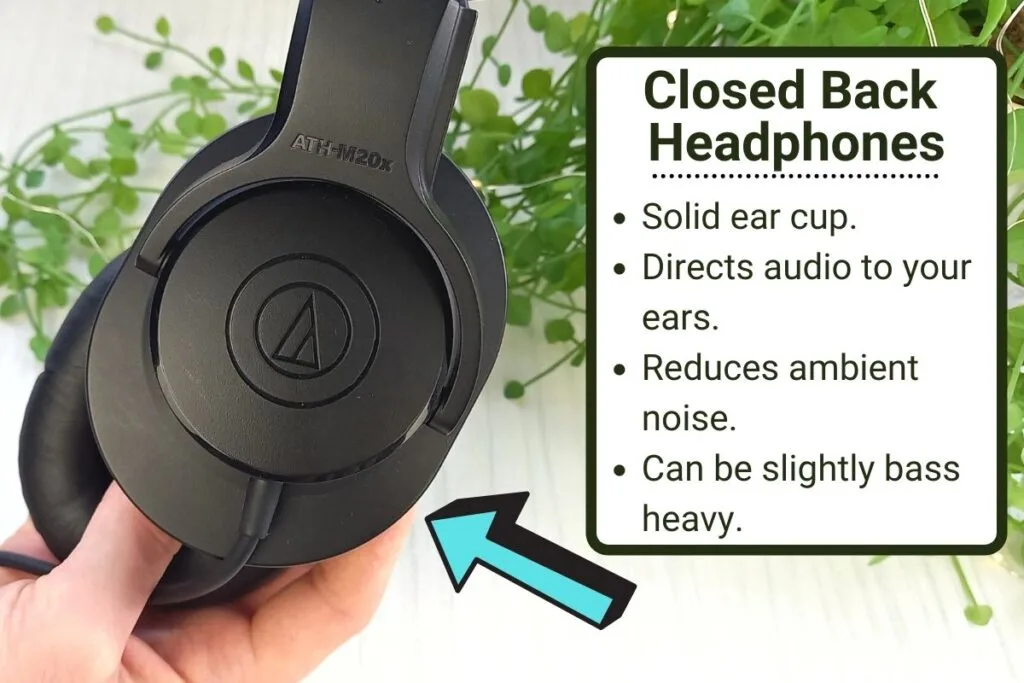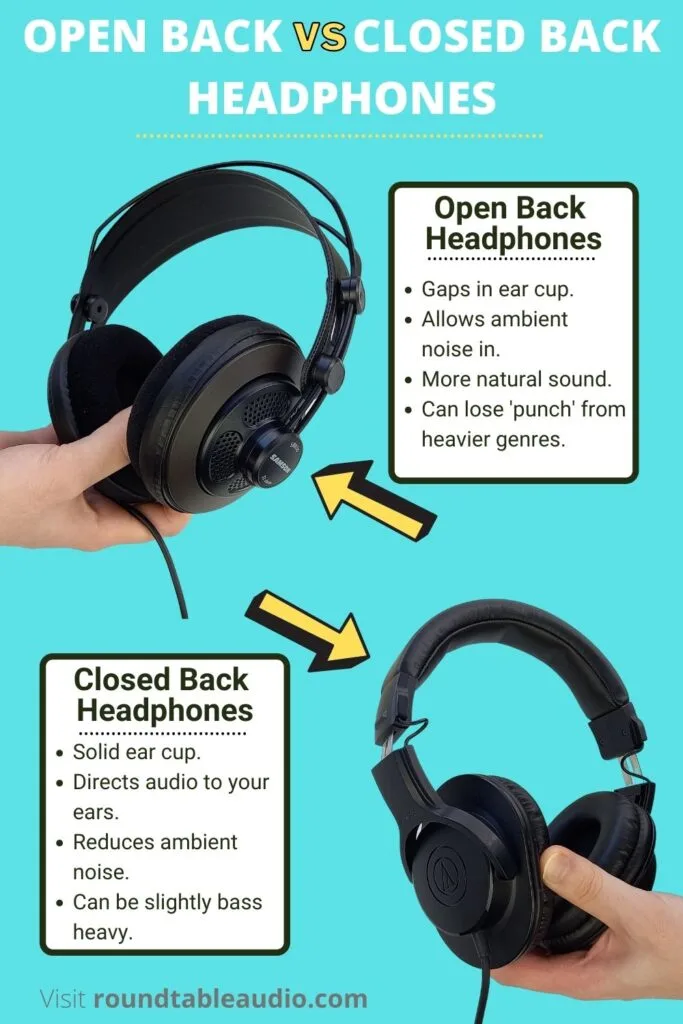It’s likely that you’ve come across the terms “open back” and “closed back” when looking to buy headphones, and have wondered what the differences are between open back vs closed back headphones. I thought the same thing, so I bought a pair of each to find out!
Open back headphones have gaps in the earpiece cups that allows air to pass through from the surrounding environment, whereas closed back headphones have solid earpiece cups.
But how does this affect their sound? And is one better than the other? I’ve written this guide to give you all the info you need about both types of headphones, what to use them for, and which are the best ones for you!

Open back vs closed back headphones: what’s the difference?
Open back and closed back headphones are both types of headphones that can be used to listen to, monitor, and analyse audio. Both have different strengths and weaknesses depending on what you’re using them for.
Open Back Headphones
Open back headphones have gaps on the back of the earpieces that allows air to move in and out of the earpiece from the surrounding environment. This creates a more natural sound to the audio you’re listening to.

If you’re listening to a podcast, it will feel more like you’re in the room with the hosts. If you’re listening to music, it’s a bit more like the band is there with you.
I’ve found that open back headphones tend to have a more balanced and lighter sound than comparable closed back models. This means that you get more of the high end from songs, which makes it sound more natural (also feels easier on your ears!), but this also means you can lose some of the punch from heavier genres of music.
Also, they’re not the best for public or noisy spaces as they let more sound in and out because of the gaps in the ear cup.
Ultimately, these headphones are designed for people who want a higher quality audio experience. Think of these as the headphones for people who want to sit down listen to a song in greater detail, or be able to better identify sounds when mixing a song.
Open back headphones are best used for:
- High quality audio enthusiasts
- Mixing and referencing in a studio
- Listening in private
Closed Back Headphones
Closed back headphones have a solid ear cup that restricts air movement. This reduces ambient sounds and allows the headphone to direct the sound from the driver (the bit that makes the noise) to your ear better. These are the type of headphone you’d use in a public space, or if you want to block out noise.

These are the most common type of headphone, and are probably the type you’re most familiar with.
I’ve found that closed back headphones tend to sound slightly more bass-heavy compared to similar open back models. This is likely a result of the increased sound pressure from the air not being able to escape the cup.
This generally results in a more forceful and energetic sound, which is great for casual listening, but may result in a loss of clarity for more detailed track referencing or mixing.
Closed back headphones are best used for:
- Live audio monitoring / recording
- Mixing in a home studio
- Listening in a public space
- Recreational listening
Here’s a handy infographic I made that summarises the differences between open back vs closed back headphones:

It’s clear that both types are fairly similar, with each slightly having their own strengths, so let’s look at some other key considerations that might affect your decision!
Price
Open back headphones are more niche than their closed back counterpart as they’re generally made for professionals and high quality audio enthusiasts. As such, they tend to have more premium components.
This also means that they come with a premium price tag, the average prices being between £110/$150 and £250/$340. The most expensive pair I found were £15,300/$20,700!
Budget options are available from around £50/$65, but as with any entry-level item, you may be sacrificing some quality. Be sure to do some research to get a better understanding of what you’re buying.
Closed back headphones are often cheaper due to their abundance in the audio market. You should be looking to spend between £50/$65 to £80/$105 for a good quality pair. Again, do your research ahead of buying to make sure you get them most for your money!
Top tip: You’re likely to be using your headphones a lot for audio production, so consider investing in a good quality pair. If you’re on a budget, consider a pair of second hand headphones! You can great quality at a cheaper price!
Monitoring / Recording
When it comes to monitoring live audio, or recording in a studio, I recommend using closed back headphones in the majority of cases.
Closed back headphones drastically reduce the amount of audio that will leave from the earpiece, which is known as “spilling“.
When you’re recording or monitoring audio, you’ll want to reduce the amount of spilling as it can be picked up by microphones. In the worst case, this could create a feedback loop (that awful screeching sound!) which would ruin your recording and could damage your hearing.
This is most likely to occur when recording vocals whilst listening to the reference track in your headphones.
You can monitor or record with open back headphones if you’re not going to be too close to a microphone, or recording a guitar or MIDI, but the versatility of the closed back headphone makes it the obvious choice for me.
Mixing / Mastering
Though mixing and mastering are different practices, I’ve put them together here as you’ll be using your headphones for the same purpose. When mixing and mastering, you want to critically analyse your recording and ensure it has a good sound profile.
Both open back and closed back headphones can be used to mix and master, in fact, I recommend them both! Especially for mastering! You’ll benefit from listening to your mix through as many different headphones and speakers as possible.
If you have to pick one, I would suggest open back headphones, as I feel they have a slight advantage as they give a better and more natural sound in my experience.
I find that closed back headphones are better for mixing than they are mastering. If you already have a set of studio monitors, I’d suggest getting closed back headphones. If you don’t have monitors, you can still use closed back headphones to master, just be mindful that your master may not be the best optimised for other devices.
Top tip: Look for “referencing” or “flat” headphones if you’re specifically mixing and mastering. This means that they won’t have frequency boosts (most often seen as “bass boost”) which will give you a more accurate sound of your recording.
Recreational listening
This is completely down to personal preference and budget!
Open back headphones are more likely to give you a better listening experience. This is due to their design, which not only improves the sound, but also other less obvious factors. The open backs mean that they’re generally lighter than closed back headphones, which means that they feel better on your head, and are less likely to cause ache over longer periods of time.
Also, the air flow from the earpiece means your ear is less likely to get too hot from extended listening.
It does mean, however, that whatever you listen to may be able to be heard by others at higher volumes. This makes them slightly less practical for listening in a public space.
Also, if you live in a noisy place, you’re probably going to be able to hear that noise as well as your music. This shouldn’t be too much of a problem if you’re listening to music at higher volumes (but be sure to take care of your ears!).
Closed back headphones are great for listening to music on the go, due to their sound isolating nature. If you’re not going to be listening to high-quality audio, these are good choice for the average user.
Top tip: Another consideration is the impedance of your headphones. It’s a fairly technical subject, but put simply, a low impedance headphone is better for more casual listening. A higher impedance headphone may require an amplifier to get the best sound quality. Generally speaking, an impedance of anywhere from 8-200 will be fine for on the go listening. From 250, you may require additional equipment.
So, which is better, open back vs closed back headphones?
If you’re just getting started with audio production or are on a budget, I suggest getting closed back headphones due to their versatility for professional and personal use.
If you’re looking to pursue music production, then I would recommend picking up a pair of both types of headphones at some point.
Hopefully, you’ll now have a better idea of the difference between open back and closed back headphones! If you have any questions, I’d love to hear from you, so please get in touch!
Related questions
Which headphone brands should I look for?
There’s a lot of good headphone brands available for both open and closed back.
Sennheiser are considered one of the best around, especially for open back headphones. Beyerdynamic, AKG, Shure, Audio-Technica and Grado also make great products for both closed and open back.
Electronics brands like Apple, Sony, and Philips also make good products, which are perfectly usable, but I would always recommend purchasing from a dedicated audio company.

Conor is a music producer, multi-instrumentalist, and all-round enthusiast from the UK with over 15 years of experience. He’s the founder and sole-content creator for the roundtable audio blog and YouTube channel.
